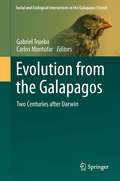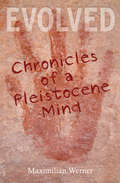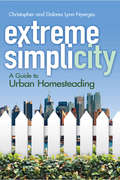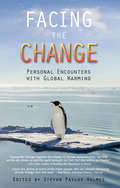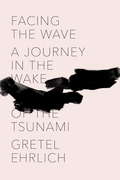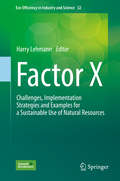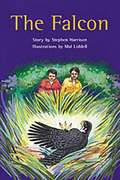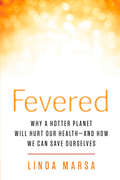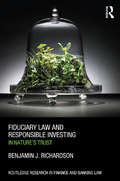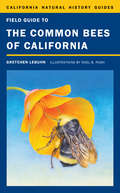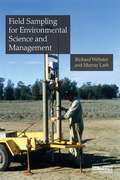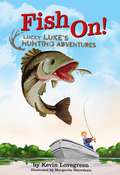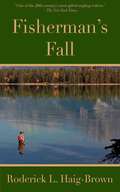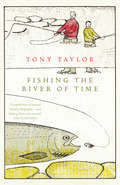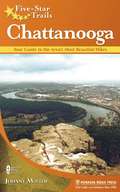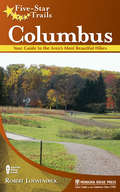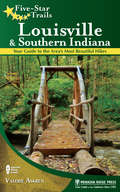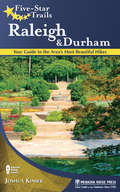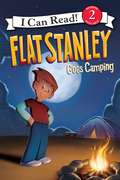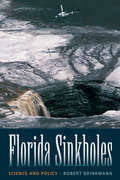- Table View
- List View
Evolution from the Galapagos: Two Centuries after Darwin
by Carlos Montúfar Gabriel TruebaThis volume is a collection of the some of the most significant lectures that well-known experts presented at our two international "summits on evolution" (2005, 2009) as updated and revised chapters. The meetings took place on one of the large islands of the Galapagos archipelago (San Cristobal) at GAIAS (Galapagos Institute for the Arts and Sciences) of the Universidad San Francisco de Quito (USFQ), Ecuador. The main goal of the two Galapagos Summits on Evolution has been to bring together scientists and graduate students engaged in the study of evolution, from life's origin to its current diversity. Because of their historical significance, the Galapagos are a unique venue for promoting comprehensive research on evolution and ecology and to make the research results available to students and teachers everywhere, but especially from developing countries. As shown by the enthusiastic attendance at both summits and the many suggestions to keep them continuing, the meetings have opened new opportunities for students from Ecuador and other Latin American countries to be inspired by some of the most brilliant minds in evolutionary science.
Evolved
by Maximilian Werner John AlcockFrom which side of the bed you sleep on to where to play a backyard game of hide-and-go-seek, Maximilian Werner examines elements of everyday behavior through the eye-opening lens of evolutionary theory in this memoir-infused nonfiction. Werner applies an intriguingly fresh take to seldom-explored habits of humans and animals alike, guiding readers backward in time to the Pleistocene."Werner's prose is compelling, his natural history is thoroughly engaging, and his line of curious inquiry is an admirable attempt to better understand humanity and its changing relationship with the external world."-Publishers Weekly"This book provides an entry in to the great epic of evolution in a way that makes it both accessible and inspiring. This is no small accomplishment and we are all indebted to Maximilian Werner."-Mary Evelyn Tucker, co- author, Journey of the Universe"Join this sensitive and perceptive naturalist as he explores his yard and nearby caves and mountains, carefully observing the activities of myriad life forms, and then reflecting insightfully on the evolutionary story we share with them. Learn from him how to feel completely at home in the world."-Loyal Rue, author of Religion is Not about God: How Spiritual Traditions Nurture Our Biological Nature and What to Expect When They Fail"Werner's book, thought-provoking and emotionally satisfying, takes us on a journey, a journey that ultimately urges each one of us to get up, go outside and hunt around the edges of our homes for the mysteries that await."-Sylvia Torti, author of The Scorpion's Tail
Extreme Simplicity: A Guide to Urban Homesteading
by Christopher Nyerges Dolores Lynn NyergesThis perfect guide to self-sufficient city dwelling was written by a pair of gentle survivalists who brought nature to their Los Angeles home. Christopher and Dolores Lynn Nyerges are prepared for everything from power failures and terrorist attacks to droughts and earthquakes. They'll show you the path to self-reliance, with strategies for coping with disasters as well as making the most of everyday life.The authors explain how to use available natural resources in an intelligent, efficient way. Their methods include growing and preserving garden produce and finding wild edibles; harvesting storm runoff for backup water supplies; preparing food with a wood stove and solar cooker; recycling everything from bottle caps to wood chips; keeping chickens, bees, and other animals; and much more.
Facing the Change
by Steven Pavlos Holmes"Amidst the current deluge of statistics about global warming, this book provides a refreshing look at how individuals are affected. This is a beautiful book to keep near, open at random, and share the words of gifted writers as they prepare for the coming changes."-Publishers Weekly"Holmes, a scholar in environmental humanities, has assembled a rich, varied collection of personal accounts and poems...An artistic and intimate approach to the problem that humanizes our concerns."--Booklist"How do you respond when the familiar, benevolent, and predictable world you count on becomes strange, hostile, and chaotic? First, you must face it. Next, bear witness. Steven Holmes has gathered compelling testimonies about the ways our earthly home is changing in the short space of our own lifetimes. They beg us to pay attention and act. We are wise to heed these passionate voices."-Chip Ward, author of Hope's Horizon"These earnest and heartfelt poems, essays, and imaginings change our discourse from data to personal testimony, channeling 'care and concern.' Maybe, just maybe, these authors who call us to 'unheroic' action 'on life's behalf' will steer us away from tragedy and chaos. 'Emerging from denial is like moving from blindness to light.' As the refrain from one writer puts it, 'Good Lord! Good luck!'"-Stephen Trimble, author of Bargaining for Eden: The Fight for the Last Open Spaces in America"Facing the Change shares the stories of some of the many people in the US and the world who are already witnessing climate change here and now. They are giving us early warning signs; it's up to all of us to act now."-Mae Boeve, executive director of 350.org"Facing the Change registers the impact of climate destabilization, not only on the sky above us and the earth beneath our feet, but also within our hearts. The voices in this eloquent and original book convey the dread and grief, the anger, but also the experiences of love and community that are intensified by the defining ecological challenge of our time."-John Elder, author of Reading the Mountains of Home, editor of The Norton Book of Nature"These eloquent stories, essays, and poems by scores of 'emotional and cultural first responders' to the effects of climate change are sure to deliver a powerful wake-up call to anyone who has supposed that nothing an individual person can say or do will affect this impending disaster."-Lawrence Buell, author of The Environmental Imagination"...the contributors to Facing the Change have begun to reveal the experiential heart of a planetary process. This is a truly important project." -Scott Slovic, editor of ISLE: Interdisciplinary Studies in Literature and EnvironmentFilled not with bare facts and dire warnings but with evocative, accessible stories, essays, and poetry, Facing the Change shows how global warming is affecting the everyday lives of people today. A wide range of writers brings courage, honesty, and insight to one of the major issues of our lives.Steven Pavlos Holmes, Ph.D., is an independent scholar in the environmental humanities, with a special interest in people's personal experiences of the natural world. His first book, The Young John Muir: An Environmental Biography, won the Modern Language Association's Prize for Independent Scholars. He lives in Jamaica Plain, Massachusetts.
Facing the Wave: A Journey in the Wake of the Tsunami
by Gretel EhrlichA passionate student of Japanese poetry, theater, and art for much of her life, Gretel Ehrlich felt compelled to return to the earthquake-and-tsunami-devastated Tohoku coast to bear witness, listen to survivors, and experience their terror and exhilaration in villages and towns where all shelter and hope seemed lost. In an eloquent narrative that blends strong reportage, poetic observation, and deeply felt reflection, she takes us into the upside-down world of northeastern Japan, where nothing is certain and where the boundaries between living and dying have been erased by water. The stories of rice farmers, monks, and wanderers; of fishermen who drove their boats up the steep wall of the wave; and of an eighty-four-year-old geisha who survived the tsunami to hand down a song that only she still remembered are both harrowing and inspirational. Facing death, facing life, and coming to terms with impermanence are equally compelling in a landscape of surreal desolation, as the ghostly specter of Fukushima Daiichi, the nuclear power complex, spews radiation into the ocean and air. Facing the Wave is a testament to the buoyancy, spirit, humor, and strong-mindedness of those who must find their way in a suddenly shattered world.
Factor X
by Harry LehmannFactor X: Re-source Designing the Recycling Society explores the role of recycling in efforts to achieve the sustainable world envisioned in the Federal Environment Ministry s Resource Efficiency Programme, known as ProgRess. The chapters build a roadmap to a Recycling Society in which the decoupling of resource consumption and economic growth is accomplished. "
Falcon (Rigby PM Chapter Books Emerald Levels 25-26, Fountas & Pinnell Select Collections Grade 3 Level P)
by Stephen HarrisonCarlos and Ricky arrive at a campsite with their father, where they discover a large injured bird. Dad identifies it as a falcon and he calls a nearby rescue center. Max and Lisa, from Raptor Center, put the falcon in a cage and take it back with them. The falcon does well and Max suggests the boys come to watch the release of the falcon in a few weeks. Later, the boys and their parents go to the place where the bird will be released. Their father tells them they should feel proud about helping to save the falcon, which flies off into the distance.
Fevered: Why a Hotter Planet Will Hurt Our Health -- and how we can save ourselves
by Linda MarsaBeyond images of emaciated polar bears and drought-cracked lakes, there remains a major part of climate change's impact that the media has neglected: how our health will suffer from higher temperatures and extreme weather. From spiraling rates of asthma and allergies and spikes in heatstroke-related deaths to swarms of invasive insects carrying diseases like dengue or West Nile and increases in heart and lung disease and cancer, the effect of rising temperatures on human health will be far-reaching, and is more imminent than we think.In Fevered, award-winning journalist Linda Marsa blends compelling narrative with cutting-edge science to explore the changes in Earth's increasingly fragile support system and provide a blueprint—a "medical Manhattan Project"—detailing what we need to do to protect ourselves from this imminent medical meltdown. In the tradition of Rachel Carson's Silent Spring, Marsa sounds the alarm on a subject that has largely been ignored by governments and policy makers, and persuasively argues why preparedness for the health effects of climate change is the most critical issue affecting our survival in the coming century.
Fiduciary Law and Responsible Investing: In Nature’s trust (Routledge Research in Finance and Banking Law)
by Benjamin J. RichardsonThis book is about fiduciary law’s influence on the financial economy’s environmental performance, focusing on how the law affects responsible investing and considering possible legal reforms to shift financial markets closer towards sustainability. Fiduciary law governs how trustees, fund managers or other custodians administer the investment portfolios owned by beneficiaries. Written for a diverse audience, not just legal scholars, the book examines in a multi-jurisdictional context an array of philosophical, institutional and economic issues that have shaped the movement for responsible investing and its legal framework. Fiduciary law has acquired greater influence in the financial economy in tandem with the extraordinary recent growth of institutional funds such as pension plans and insurance company portfolios. While the fiduciary prejudice against responsible investing has somewhat waned in recent years, owing mainly to reinterpretations of fiduciary and trust law, significant barriers remain. This book advances the notion of ‘nature’s trust’ to metaphorically signal how fiduciary responsibility should accommodate society’s dependence on long-term environmental well-being. Financial institutions, managing vast investment portfolios on behalf of millions of beneficiaries, should manage those investments with regard to the broader social interest in sustaining ecological health. Even for their own financial self-interest, investors over the long-term should benefit from maintaining nature’s capital. We should expect everyone to act in nature’s trust, from individual funds to market regulators. The ancient public trust doctrine could be refashioned for stimulating this change, and sovereign wealth funds should take the lead in pioneering best practices for environmentally responsible investing.
Field Guide to the Common Bees of California
by Gretchen LebuhnThis engaging and easy-to-use natural history guidebook provides a thorough overview of native and honey bee biology and offers tools for identifying the most common bees of California and the Western United States. Full-color illustrations introduce readers to more than 30 genera of native bees, noting each one's needs and habits and placing them in their wider context. The author highlights bees' ties to our own lives, the food we eat, and the habitat we provide, and suggests ways to support bees in our own backyards. In addition to helping readers understand and distinguish among major groups of bees, this guide reveals how bees are an essential part of healthy ecosystem and how many plants, including important crop plants, depend on the pollination they provide. As growing evidence points to declining bee populations, this book offers critical information about the bond between plants and pollinators, and between humans and nature. Thoroughly researched and full of new insights into the ancient process of pollination, Field Guide to the Common Bees of California; Including Bees of the Western United States is invaluable for the window it opens onto the biodiversity, adaptive range, and complexity of invertebrate communities.
Field Sampling for Environmental Science and Management
by Richard Webster Murray LarkScientists and consultants need to estimate and map properties of the terrestrial environment. These include plant nutrients and parasites in soil, gaseous emissions from soil, pollutant metals and xenobiotics in waste and contaminated land, salt in groundwater and species abundances above ground. The scale varies from small experimental plots to catchments, and the land may be enclosed in fields or be open grassland, forest or desert. Those who sample the variables to obtain the necessary data need guidance on the design and analysis of sampling methods for their conclusions and recommendations to be valid. This book provides that guidance, backed by sound rationale and statistical theory. It concentrates on design-based sampling for estimates of mean values of environmental properties, emphasizing replication and randomization. It starts with simple random sampling and then progresses to more efficient designs, such as spatially stratified random sampling, stratification by classes and cluster sampling. It includes a section on purposive sampling in classical soil survey, which is relevant to other environmental properties such as vegetation. It also describes the effects of bulking on errors and the use of ancillary information and regression to improve estimates. The authors draw the important distinction between design-based sampling for estimating means and model-based methods (geostatistics) for local spatial prediction and mapping, and focus on the latter. They describe designs suitable for computing variograms and prediction by kriging, as well as a staged approach, so that sampling is neither inadequate nor excessive, and designs adapt as knowledge is accumulated. Including numerous worked case studies of sampling in agriculture, ecology and environmental science, the book will be of immediate practical value.
Fish On! (Lucky Luke's Hunting Adventures)
by Kevin LovegreenA perfect day on a magical lake filled with fish. The smell of pine trees, the bright sunshine, a nice breeze: the stage is set for a great adventure! Join Luke at his grandparents' lake cabin, tucked way back in the woods, as he experiences an amazing morning of fishing. Luke has to find the hot spots, pick the right lures, and chase a lunker that steals his lucky Basserino. It's the kind of morning anyone who's ever held a rod dreams of!
Fisherman's Fall
by Roderick L. Haig-BrownOriginally published in 1964, Fisherman's Fall brings a unique perspective to the world of fall fishing. In the preface, Robert L. Haig-Brown ruminates on the attempts to preserve the salmon and trout in the rivers of British Columbia. What we know could save them, yet what we do contradicts that knowledge. Gaining the knowledge in this book will help fishers learn the nature of the fish and might even inspire some to contribute to their preservation.Fisherman's Fall gives fishers all the tools to become adept at fishing the rivers of British Columbia as well as firsthand knowledge of the fish of those rivers and their habits. In fabulous prose, readers will discover the unique fishing facts and techniques that accompany the fall season, differences between salmon in salt water and fresh water, the ocean years of salmon, the nature of estuaries, steelhead mysteries, and what makes an ideal stream.Besides gathering wise information, readers get to glimpse the inner thoughts of a fisherman in the chapters of Haig-Brown's own thoughts while fishing. These wise words will speak to any fisher, and they will even speak to those who have never been on a river. Combining angling advice and inner reflection, this book is a must-have for fishermen and fisherwomen of all ages.
Fishing the River of Time
by Tony TaylorAt age eighty, Tony Taylor journeys from Sydney, Australia, to British Columbia to fish the Cowichan River with his eight-year-old grandson, Ned. The trip is an opportunity for Tony to return to a landscape that has had a profound effect on his life and his way of thinking, and to share this place with his grandson. As Tony teaches Ned the patient art of fly-fishing, a lifetime of memories, thoughts, and stories unspool in peaceful reflections by the water's edge. Fishing the River of Time is an elegant meditation on nature, life, and family, written with warmth and wisdom. It inspires self-reflection and an appreciation of the natural world and the fundamentals of our human experience. It is destined to become a classic work of simple living in the mold of Henry David Thoreau's Walden.
Five-Star Trails: Chattanooga
by Johnny MolloyFive-Star Trails: Chattanooga is a handy guide for area residents, vacationers seeking outdoor fun, and for business travelers with a free afternoon. With a diverse collection of hiking routes, the book offers choices for everyone from solo trekkers to companions to families with either youngsters or oldsters to consider.This book profiles close-in urban and suburban locations that can satiate scenery-hungry residents and also offers routes of superlative beauty in the adjacent local, state, and national parks. All this adds up to a hiker's nirvana.Chattanooga is ideally situated to enjoy some of the Southeast's best scenery. To the east and south are two huge tracts of sublime and primitive national forest land -- the Chattahoochee and the Cherokee -- much within an easy drive of Chattanooga. The national forests also offer camping, hunting, fishing, nature study, and more. To the west rises the Cumberland Plateau, with its finest features protected under the umbrella of Tennessee's state park system, centered by the Volunteer State's master path, the Cumberland Plateau. The geologically fascinating Cumberland offers hiking routes along rushing rivers, deep gorges, wild waterfalls, and other rock features.Other parks lie within the bounds of Alabama and Georgia, from Little River Canyon to Cloudland Canyon to Chickamauga Battlefield. Lookout Mountain and other local hiking destinations only add to the possibilities. The wide variety of trails, distances, difficulties, and destinations will suit any hiker's mood and company.Researched, experienced, and written by a local author, the guide provides in-depth trail descriptions, directions, and commentary on what to expect along the way. Each hike features an individual trail map, elevation profile, and at-a-glance key info, helping readers quickly determine the perfect trip for them when they are ready to head out the door.Sized to fit in a pocket, the book is convenient to keep in the car or toss into a backpack. Driving directions direct hikers to the nearest trailhead parking areas, and GPS trailhead coordinates get them to the start of the trail.
Five-Star Trails: Columbus
by Robert LoewendickFive-Star Trails: Columbus is the most current and comprehensive guide to hiking the area and rates hikes on the following factors: scenery, trail condition, difficulty, appropriateness for children, and solitude. Each hikes also includes detailed landmarks, flora, fauna, and local history. In this Columbus guide, an impressive collection of routes ranges north, east, south, and west from the metro center, as well as within the urban setting. This capital city is rich in metro parks, natural areas and preserves, state parks, and state forests. And this diversity of hiking terrain invites all levels of abilities and skills. Thus, this guidebook is geared not only to avid trekkers seeking more challenge than a paved neighborhood path, but also to families and senior citizens. Outdoor enthusiasts of every stripe will have reason to grab this book and, well, take a hike. Sized for easy carrying or tossing into a backpack, this handy guide will quickly become a treasured resource among Columbus locals and visitors alike.
Five-Star Trails: Louisville and Southern Indiana
by Valerie AskrenKnown as the City of Parks, Louisville has long valued the natural landscape and the provisioning of outdoor recreation. In 1891 Frederick Law Olmsted, the father of American landscape architecture, was commissioned to develop an extensive park system for Louisville that eventually included 18 parks and 6 interconnecting parkways. Since that time, Louisville has continued to invest resources to build a first-class park system. Nestled within the Ohio Valley, and bordered by the knobs region to the south and the heavily forested areas of Indiana to the north, Louisville lies at the heart of an endless array of hiking opportunities.Five-Star Trails: Louisville showcases many of the hiking trails and walking paths within the city or within easy driving distance in central Kentucky and southern Indiana. Designed specifically for day trips, this book includes several of the area's most popular parks, as well as many of the lesser-known hiking trails in nature preserves, wildlife management areas, and national forests.
Five-Star Trails: Raleigh and Durham
by Joshua KinserFive-Star Trails: Raleigh and Durham is a guide to the best day-hiking trails within a two-hour drive of the urban areas of Raleigh and Durham. Raleigh is North Carolina's capital and an anchor for the state's famous Research Triangle that includes Durham and Chapel Hill. Amid this metropolitan complex that also embraces Cary, Apex, and Wake Forest-home to more than 1.7 million people-the author leads readers to myriad places for scenic beauty, to sites of historic significance, and to neighborhoods that showcase the charms of urban life. All of the routes stay true to the book's "Five-Star Trails" title, based on the book series' rating system for scenery, trail condition, suitability for children, difficulty level, and solitude. To be selected for the book, each trail must truly shine in one or more of those areas while, at the same time, all of the trails combine to offer diversity for a wide range of hikers. Thus, this is the guidebook for a hiker seeking an arduous climb to a scenic overlook as much as it is for a weekend walker who wants an easy trail for his or her family.
Five-Star Trails: South Carolina Upstate
by Sherry JacksonThe South Carolina Upcountry is gaining more popularity and people visiting will need to know how to discover all it has to offer. Outdoor activities here abound and there are a good variety of trails for hikers of all levels. From waterfalls to amazing mountain views, each trail offers hikers an incredible experience. Since the Upcountry is relatively "undiscovered", there are very few books that have a true compilation of hikes in the area. Five-Star Trails: South Carolina Upstate will bring together those hiking trails that offer a "five star" experience.Each trail has been thoroughly researched, recently hiked and includes a detailed description, trail profiles and map. At a glance ratings in important categories such as Scenery, Trail Condition, Difficulty, Solitude and appropriateness for children let you quickly select a trail that fits your tastes and ability. Other useful information such as fees, restrictions for dogs on the trail as well as advice on when to visit offers you the best information so you can plan your trip with ease. Five-Star Trails: South Carolina Upstate provides directions and commentary for each trail on what to expect along the way, making it more than just an average guidebook. This guide will lead hikers off the beaten path to find exceptional beauty as well as peace of mind. The diversity in terrain invites all levels of abilities and skills. Outdoor enthusiasts of every level will have reason to grab this guide and take a hike.This book offers easy-to-moderate trails that are within driving distance from a reader's workplace or home in the South Carolina Upstate. Without this book, they might miss the hidden hiking treasures of the area, but with the expert help of Sherry Jackson, readers will enjoy the region's best trails!
Flat Stanley Goes Camping (I Can Read Level 2)
by Jeff BrownElementary-school kids love Jeff Brown’s classic character, Flat Stanley—the amazing paper-thin boy who can slide under doors, fly like a kite, and travel by mail.In his latest fun-filled adventure, Flat Stanley Goes Camping, Stanley and the Lambchop family take a trip to the woods. It gets a little scary when Stanley and his brother, Arthur, run away from a skunk—and straight toward the edge of a cliff!Flat Stanley Goes Camping is an I Can Read book designed to engage and excite child readers. It is a Level 2 book, which means it is perfect for kids who are starting to read on their own but still need some help.
Floral Ornament (Dover Pictorial Archive Ser.)
by Carol Belanger GraftonGraphic artists and craftworkers in search of attractive and unusual floral motifs will find them in this rich treasury of exquisite designs. Carol Belanger Grafton has selected over 350 handsome floral and foliated arrangements from a wide variety of Victorian-era sources. Reproduced from such rare publications as L'Art Pour Tous, The Art Journal, The Illustrated London News, Harper's Weekly, and The British Printer, these lovely images appear in a wide variety of configurations -- as decorative embellishments on a saucer and teacup, on picture frames and wall sconces, as flowing patterns that lend themselves well for use as frames and borders, and much more. These imaginative accents will not only enhance such print projects as brochures, newsletters, posters, signs, and catalog copy, they'll also serve as a source of inspiration to anyone working in the arts and crafts.
Florida Sinkholes: Science and Policy
by Robert BrinkmannBelow the live oaks, palm trees, cypress swamps, and springs, water is slowly wearing away the limestone bedrock of Florida. The erosion is often unseen, and over time it can result in shocking cave-ins like the destructive spectacle of the 1981 Winter Park sinkhole.Florida Sinkholes--the first comprehensive book on the subject--is an easy-to-follow guide to understanding how sinkholes form and what to do about Florida's sometimes pockmarked landscape. City planners, construction managers, developers, and homeowners alike will find this book invaluable because of the heavy impact and increasing frequency of sinkhole formation in the state. Amateur geologists will be fascinated by the subtle forces of nature that can make solid rock disappear. Tackling the problem of sinkholes in useful detail, this book packs an abundance of sound scientific fact into frank, readable language. Learn about the captivating workings of karst, a term for the swiss cheese-like formations of soluble rock that underlie the peninsula. Discover current state-of-the-art approaches to mapping sinkholes and subsurface voids. Review such practical concerns as structural damage, repairs, insurance problems, and management of karst lands. Examine case studies of several notable sinkholes and sinkhole events. Even before you've finished reading, you may find yourself itching to get out and visit these intriguing marvels of Florida geology for yourself.
Flowering Earth
by Donald Culross PeattieFlowering Earth is an extraordinary work in which Peattie explores the origin and significance of plant life with an unmatched sense of astonishment and reflection. According to The New York Times, his prose in Flowering Earth "is pervaded by a continuous sense of beauty and illuminative insight," and Books hails it as a piece "for people who are refreshed by any sort of emancipation from the trivial..."
Flowering Earth
by Donald Culross PeattieFlowering Earth is an extraordinary work in which Peattie explores the origin and significance of plant life with an unmatched sense of astonishment and reflection. According to The New York Times, his prose in Flowering Earth "is pervaded by a continuous sense of beauty and illuminative insight," and Books hails it as a piece "for people who are refreshed by any sort of emancipation from the trivial..."
Flying Blind: One Man's Adventures Battling Buckthorn, Making Peace with Authority, and Creating a Home for Endangered Bats
by Don MitchellWhen Middlebury writing professor Don Mitchell was approached by a biologist with the Vermont Fish and Wildlife Department about tracking endangered Indiana bats on his 150-acre farm in Vermont's picturesque Champlain Valley, Mitchell's relationship with bats—and with government—could be characterized as distrustful, at best.But the flying rats, as Mitchell initially thinks of them, launched him on a series of "improvements" to his land that would provide a more welcoming habitat for the bats—and a modest tax break for himself and his family. Whether persuading his neighbors to join him on a "silent meditation," pulling invasive garlic mustard out of the ground by hand, navigating the tacit ground rules of buying an ATV off Craigslist, or leaving just enough honeysuckle to give government inspectors "something to find," Mitchell&’s tale is as profound as it is funny—a journey that changes Mitchell&’s relationship with Chiroptera, the land, and, ultimately, his understanding of his own past.Ruminating on the nature of authority, the purview of the state, and the value of inhabiting one&’s niche—Mitchell reveals much about our inner and outer landscape, in this perfectly paced and skilled story of place.
